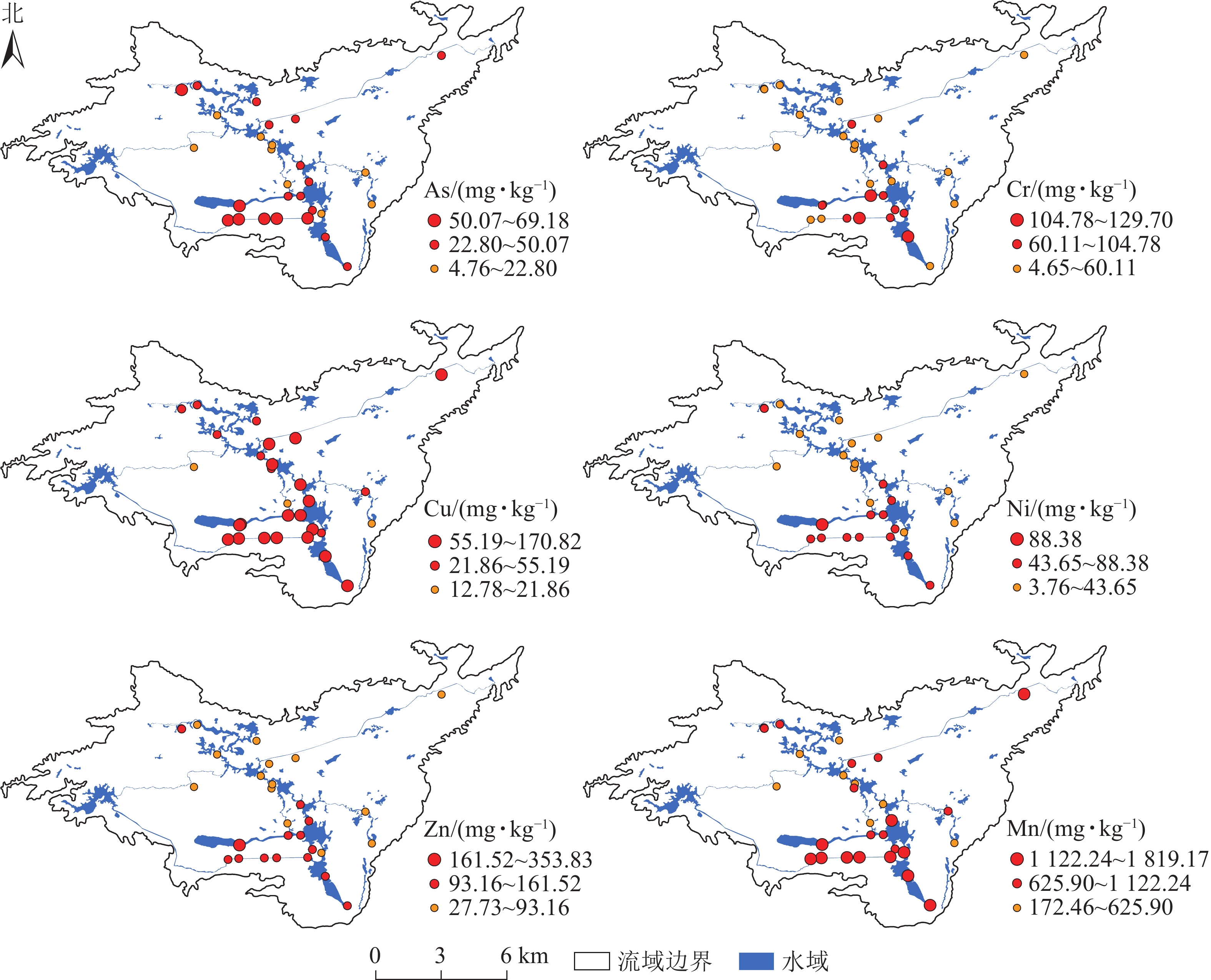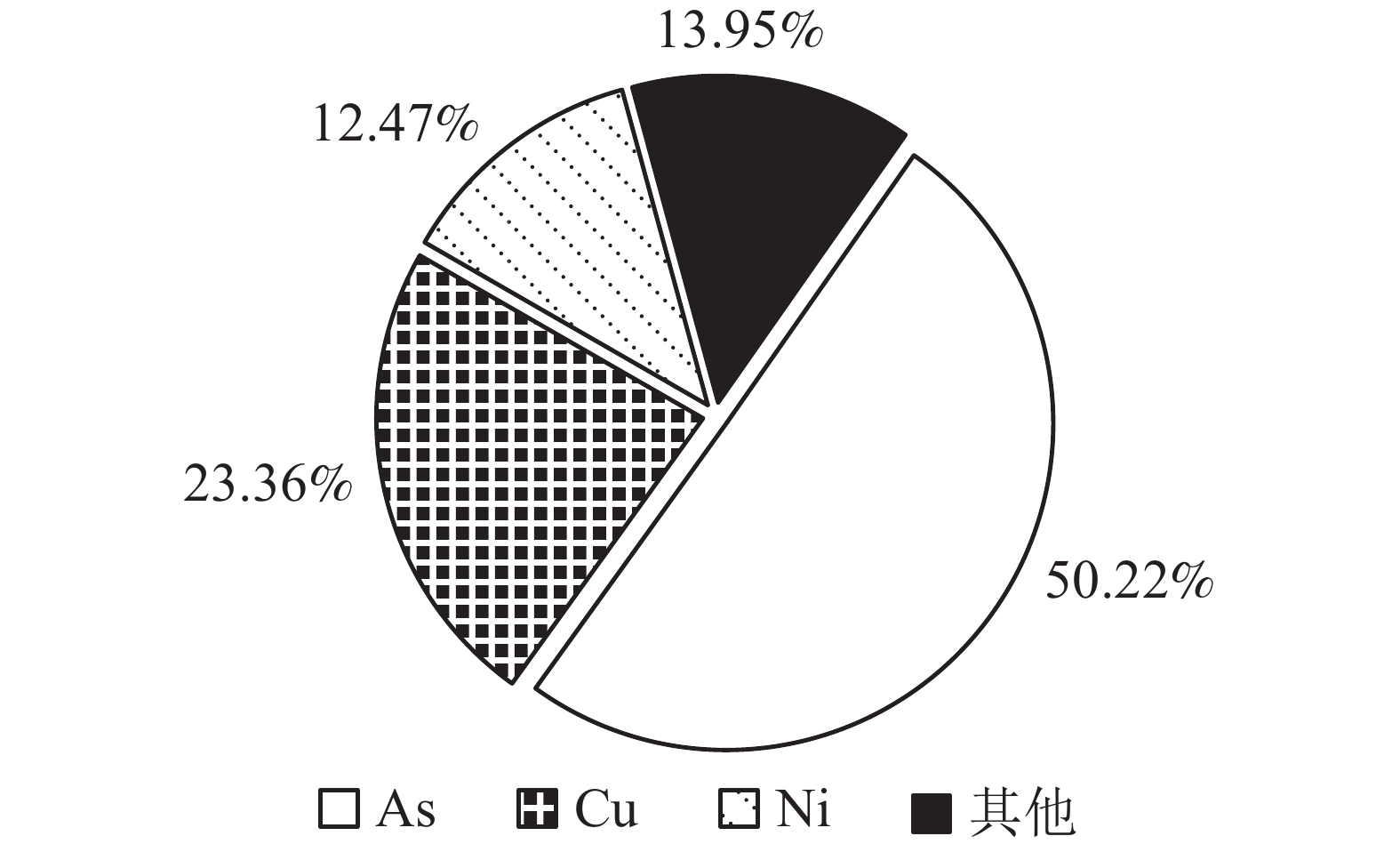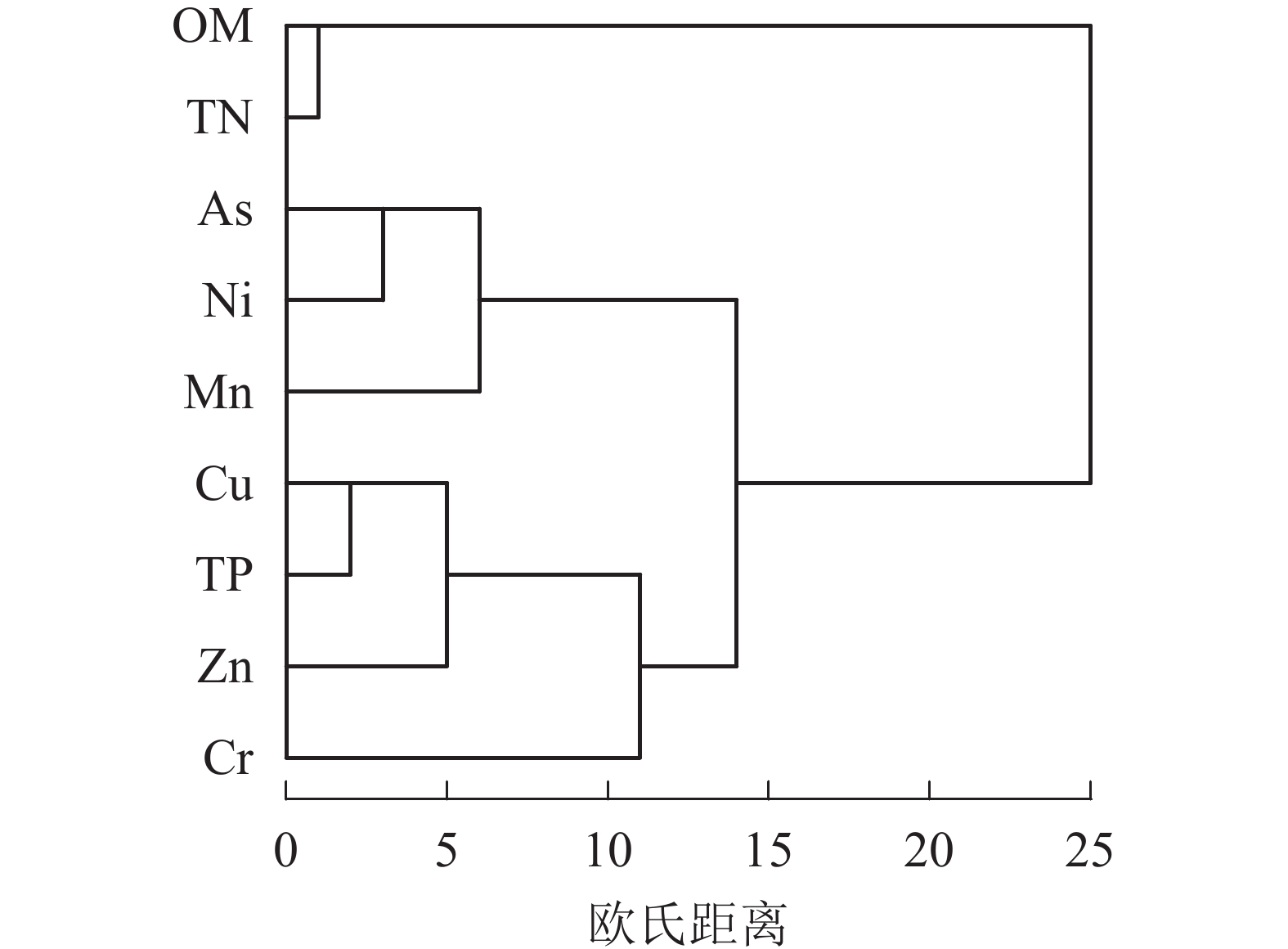-
沉积物是水环境的重要组成部分,既是水体污染的“源”,也是污染物的“汇”[1],沉积物满足一定条件和经过一系列反应后,会吸附污染物并转移至悬浮颗粒及周围水体中造成污染[2-3]。重金属作为重要的环境污染物,在受污染水环境中分布相对稳定,具有较强且持久的生物毒性及食物链富集放大效应等特征[4]。近年来研究热点多侧重于水污染评价、沉积物重金属污染等方面[5-8],而沉积物是水环境中重金属污染程度的“指示剂”[9],从侧面反映水体重金属污染程度,因此探析水和沉积物整体的污染特征,对揭示流域重金属污染及风险评价具有重要意义。普者黑流域地处珠江源头和长江、红河上游,流域内分布有54个湖泊,312座孤峰,83个溶洞,15条河流和120 km的地下暗河,是云南峰丛洼地分布最为集中的区域,集喀斯特孤峰群、湖泊群、溶洞群和湖滨湿地等多种地貌于一体,在西南部滇黔桂喀斯特地貌中极具代表性,形成了独特的自然景观和特殊的岩溶湖泊生态系统,具有较高的研究及保护价值。近年来该区域的研究主要集中在景观格局演变[10-11]、沉积物磷赋存形态[12]、水环境质量评价方面[13-14]。本研究利用地累积指数和潜在生态风险指数等方法,对该流域表层水和沉积物的重金属污染水平及生态风险进行评价和源头追溯,以期为普者黑流域重金属污染控制、生态修复等提供理论依据。
HTML
-
普者黑流域位于滇东南丘北县境内(24°05′~24°12′N,103°55′~104°13′E),流域面积388 km2,海拔1 446~1 462 m,是典型的湖泊、孤峰、峰林复合生态系统。湖区容水总量约7 000 万m3,水深3~8 m,为南盘江上游,属于珠江水系。该区属亚热带季风气候,降水多在5−10月,年平均气温为16.4 ℃,年平均降水量为1 206.8 mm。流域内有板桥河(BQ)、增产水库(ZC)和响水河(XS)3条主要入湖河流。
-
样品采集于2018年4月。利用1∶50 000数字高程模型(DEM)数据,在ArcGIS 10.2水文分析模块支持下,将整个流域划分成26个子流域,根据每个子流域的出水口和入水口情况,设置30个取样点。其中,湖泊北部(1~6)、中部(7~12)和南部(13~18)各6个,共计18个样点;响水河(XS-1、XS-2、XS-3、XS-4、XS-5)5个;增产水库(ZC-1、ZC-2、ZC-3、ZC-4)4个;板桥河(BQ-1、BQ-2、BQ-3)3个(图1)。
取样前,预先用王水[V(盐酸)∶V(硝酸)=3∶1]浸泡过的洁净采样瓶,用表层水(水下约50 cm)润洗3~4次;表层水使用450 mL塑料瓶采集。使用活塞式柱状底泥采样器,取原状土柱后,收集0~15 cm表层沉积物土样,将混合后样品放入自封袋中冷冻保存。室温风干后用玛瑙研钵研磨至粉状,经100目尼龙筛网筛分。
采用离子体光谱仪(美国安捷伦ICP-OES700)进行重金属元素:砷(As)、铬(Cr)、铜(Cu)、锌(Zn)、锰(Mn)和镍(Ni)的总量测定;总磷(TP)采用酸熔-钼锑抗比色法测定;总氮(TN)采用半微量凯式法测定;有机质(OM)采用重铬酸钾容量法[14-15]测定。
-
地累积指数法[16]考虑了人为活动、环境地球化学背景值以及自然地质过程引起的背景值变动,直观得出重金属污染级别。计算公式为:
式(1)中:Igeo为地累积指数;wi为沉积物中重金属i的质量分数(mg·kg−1);
$ {B}_{i} $ 为沉积物中重金属i的地球化学背景值(mg·kg−1),本研究采用全国土壤重金属环境背景值[17],As、Cr、Cu、Zn、Mn、Ni的背景值分别为18.4、65.2、46.3、89.7、626、51 mg·kg−1;k是由于成岩作用可能会引起背景值的变动而设定的常数,一般取1.5。根据Igeo将沉积物中重金属的污染程度分为7个等级[18](表1)。地累积指数(Igeo) 级别 污染程度 Igeo≤0 0 清洁水平 0<Igeo≤1 1 轻度污染 1<Igeo≤2 2 偏中度污染 2<Igeo≤3 3 中度污染 3<Igeo≤4 4 偏重度污染 4<Igeo≤5 5 重度污染 Igeo>5 6 严重污染 Table 1. Degree of heavy metal pollution and the classification of geoaccumulation index (Igeo)
-
使用HAKANSON[19]的方法对表层沉积物重金属进行潜在生态风险评价,该方法考虑了重金属含量、污染物种类、毒性水平和水体对金属污染的敏感性等4个影响因素[20];潜在生态风险指数(IR)计算方法如下:
式(2)中:
$E_{\rm{r}}^i$ 为重金属i的潜在生态风险指数;${T}_{{\rm{r}}}^{i}$ 为重金属i的毒性系数;$C_{\rm{f}}^i$ 为重金属i相对参比值的污染指数;Ci为重金属i的实测浓度;$ {C}_{n}^{i} $ 为重金属i的评价参比值。其中,As、Cr、Cu、Zn、Mn、Ni的毒性系数分别为10、2、5、1、1、5[21];根据IR的大小,将重金属综合潜在风险分为5个等级(表2)。单项潜在生态
风险指数($ E_{\rm{r}}^i$)单项潜在生态
风险等级潜在生态
风险指数(IR)综合潜在生态
风险等级$E_{\rm{r}}^i$<40 低(Ⅰ) IR<150 低(Ⅰ) 40≤$E_{\rm{r}}^i$<80 中等(Ⅱ) 150≤IR<300 中等(Ⅱ) 80≤$ E_{\rm{r}}^i$<160 较重(Ⅲ) 300≤IR<600 较重(Ⅲ) 160≤$E_{\rm{r}}^i$<320 重(Ⅳ) 600≤IR<1 200 重(Ⅳ) $E_{\rm{r}}^i$≥320 严重(Ⅴ) IR≥1 200 严重(Ⅴ) Table 2. Potential ecological risk assessment index and classification criteria
-
通过Excel预处理数据;使用SPSS 19.0进行主成分分析和聚类分析;利用ArcGIS 10.2绘制重金属元素空间分布图;通过Pearson相关系数分析各元素之间的相关性。
1.1. 研究区概况
1.2. 样品采集与处理
1.3. 评价方法
1.3.1. 地累积指数法
1.3.2. 潜在生态风险指数法
1.4. 数据处理
-
由表3可知:表层水的重金属质量浓度平均值低于GB 3838−2002《地表水环境质量标准》的Ⅰ类标准限值,从大到小依次为As、Mn、Ni、Cu,Cr和Zn未检出。可见,该流域表层水的重金属占水质成分较低,重金属在该流域表层水内不是主要污染因子。
元素 最小值/(μg·L−1) 最大值/(μg·L−1) 平均值/(μg·L−1) 标准差/(μg·L−1) 变异系数/% 地表水Ⅰ类标准/(μg·L−1) 超标率/% As 3.38 41.89 17.64 10.49 0.59 50 0 Cr − − − − − 10 0 Cu 0.02 10.66 2.39 2.84 1.19 10 6.67 Zn − − − − − 50 0 Mn 0.16 59.11 9.78 14.56 1.49 100 3.33 Ni 2.39 18.96 6.71 4.95 0.73 20 0 说明:−表示未检出。Cr、Zn检出限分别为4和10 μg·L−1 Table 3. Descriptive statistics of heavy metal content in surface water
由表4可知:表层沉积物的重金属质量分数从大到小依次为Mn、Zn、Cu、Cr、Ni、As,分别是各自背景值的1.68、1.33、3.33、0.96、1.01和1.59倍,除Cr外,均高于全国土壤重金属背景值,且As、Cu、Mn和Zn有超过50%的样点高于相应背景值,Cu有90%的样点超过背景值,Cr、Ni分别有36.7%和46.7%的样点超过背景值。与国内其他湖泊相比,研究区Cr、Ni、Zn都处于较低水平,As和Cu处于较高水平;其中,As质量分数是太湖的2.3倍,Cu质量分数是阳澄湖和洞庭湖的1.9倍。Mn质量分数仍处于较高水平,其平均值为全国土壤背景值的1.8倍,为阳宗海的1.5倍。除As和Cu外,流域其余4类重金属虽然受不同程度人为活动的影响,但重金属质量分数较低,污染贡献率小。
Table 4. Comparison of heavy metal contents in surface sediments of different lakes
由图2可知:表层沉积物中Cr、Ni和Zn的空间分布具有一致性,在湖泊不同断面上由北向南呈逐渐增加的趋势,高值均出现在增产水库、响水河和湖泊下段国家湿地公园区域。流域北部的板桥河中As和Mn也较高,Cu空间分布则不同,除5、12和14号采样点外,所有采样点Cu均高于土壤背景值。As平均质量分数在空间上从大到小依次为北部、南部、中部,在3条入湖河流中从大到小依次为XS、ZC、BQ;Cu平均质量分数在空间上从大到小依次为中部、南部、北部,在3条入湖河流中从大到小依次为XS、ZC、BQ;由此可见,入湖河流重金属质量分数显著高于湖泊主体,是污染物传输的重要通道。Mn和Ni的变异系数分别为47.3%和53.8%,As、Cr、Cu和Zn的变异系数超过了60%,分别为64.4%、65.1%、61.9%和62.3%,表明重金属质量分数存在空间差异性。当变异系数超过20%时,人类活动是导致重金属空间分布存在差异的主要驱动因子[27]。
-
地累积指数评价表明:Cr、Ni和Zn的Igeo均小于1,处于低污染水平(表5)。通过各采样点污染程度分析,污染程度由高到低依次为As、Cu、Mn、Zn、Cr、Ni。其中,Ni污染程度最低,有96.6%采样点为清洁水平;Zn则有3.3%的采样点为偏中度污染;As和Cu均有56.7%的采样点处于清洁水平,轻度污染所占比例分别为26.6%和40.0%,As偏中度污染程度是Mn的1.8倍;Mn的清洁水平和轻度污染相当。仅As有16.7%的样点Igeo大于1,其余元素均小于1。可见,普者黑流域沉积物中重金属污染较少,保留了原有沉积物特征,但As污染是目前最大的潜在风险。
Igeo 级别 污染程度 各采样点重金属污染程度所占比例/% As Cr Cu Ni Zn Mn Igeo≤0 0 清洁水平 56.7 90.0 56.7 96.6 80.0 50.0 0<Igeo≤1 1 轻度污染 26.6 10.0 40.0 3.4 16.7 50.0 1<Igeo≤2 2 偏中度污染 16.7 3.3 3.3 2<Igeo≤3 3 中度污染 Table 5. Pollution assement of heavy metals in surface sediment
于霞等[28]研究发现:赤水河流域沉积物重金属的Igeo从大到小依次为Cd、Mn、Ni、As、Cu、Zn、Hg,其中Cd的平均Igeo为1.40,其他元素均小于0;但滇池外海[22]沉积物重金属的Igeo从大到小依次为Cd、Pb、Cu、Hg、As、Cr、Zn,其他重金属(除As、Cu和Cr外)均大于1,高于普者黑流域,处于偏中度污染及以上水平。As、Mn、Cu的污染程度均较高,而Cr、Zn的Igeo均处于轻度污染或清洁水平之上。可见,普者黑流域、赤水河流域及滇池外海的主要污染并不是Cr和Zn积累所导致的。
-
由图3可知:单项重金属潜在生态风险指数从大到小依次为As、Cu、Ni、Cr、Mn、Zn,潜在生态风险指数均小于40,风险较低,与地累积指数评价结果一致。图4表明:普者黑流域表层沉积物中重金属的潜在生态风险主要由As、Cu和Ni引起,3种重金属的生态风险指数对总的潜在风险指数贡献率较高,其他3种重金属的贡献率仅为13.95%。As和Cu是该流域表层沉积物中重金属主要潜在生态风险因素,而各重金属中生态风险指数最小的为Mn和Zn。张玉玺等[23]研究认为:阳宗海沉积物中潜在生态风险贡献最大的是As和Cu,最小的是Ti和Mn,这与本研究结果相似。
重金属在普者黑流域表层沉积物各采样点平均生态风险指数(IR)为31.7,小于其限值(150)。从重金属潜在生态风险指数空间分布(图5)来看:湖泊下段风险高于中段和上段,入湖河流中响水河风险最高,其次是增产水库,板桥河相对较低。且生态风险变异指数为56.0%,说明潜在生态风险指数受空间差异的影响。
-
沉积物中重金属相关性越大,来源越相似[29]。相关分析(表6)表明:As、Cr、Cu、Mn、Ni、Zn和TP两两之间呈显著正相关(P<0.05),Cu、Ni与OM之间呈显著(P<0.05)或者极显著(P<0.01)正相关;Cu与TN之间呈显著正相关(P<0.05),表明研究区重金属大部分具有相似来源,且可能产生复合性污染。
元素 TP OM TN As Cr Cu Mn Ni Zn TP 1 OM 0.59** 1 TN 0.53** 0.93** 1 As 0.61** 0.19 0.12 1 Cr 0.51** 0.29 0.15 0.52** 1 Cu 0.85** 0.51** 0.40* 0.70** 0.72** 1 Mn 0.41* 0.23 0.14 0.71** 0.43* 0.54** 1 Ni 0.61** 0.38* 0.29 0.83** 0.71** 0.76** 0.74** 1 Zn 0.65** 0.36 0.31 0.69** 0.36* 0.78** 0.58** 0.68** 1 说明:*P<0.05;**P<0.01 Table 6. Correlation between heavy metals in sediments and soil chemical characteristics
-
通过主成分分析对重金属质量分数初始数据进行检验,结果均符合检验要求。前2个主成分的方差累积贡献率达77.82%,矩阵旋转之后提取的2个主成分特征值均大于1,方差累积贡献率也为77.82%。可见,旋转后的方差累积贡献率无明显变化,满足主成分分析原则。第1主成分中Cu、Ni、TP、As和Zn具有较高的载荷,Cr和Mn低于组内其他组分的荷载;OM和TN在第2主成分中具有较高的载荷(表7)。
元素 原始荷载值 旋转后荷载值 主成分1 主成分2 主成分1 主成分2 As 0.82 −0.39 0.91 0.03 Cr 0.69 −0.20 0.71 0.15 Cu 0.93 −0.01 0.82 0.43 Mn 0.71 −0.37 0.80 0.01 Ni 0.89 −0.25 0.91 0.20 Zn 0.81 −0.11 0.77 0.28 TP 0.84 0.22 0.64 0.58 OM 0.60 0.76 0.18 0.95 TN 0.51 0.82 0.06 0.96 Table 7. Rotation matrix factor loading of heavy mental content in sediments
聚类分析(图6)表明:9种组分大致可分为3类:第1类为As、Ni和Mn;第2类为Cu、TP、Zn和Cr;第3类为OM和TN。
相关重金属元素溯源研究显示:市郊农田土壤中As严重超标,说明其主要来自农药和化肥的使用,进入水体后被水中阳离子吸附形成难溶化合物[30],Cr主要来自于化工等企业污染排放[31];Cu、Zn和Cr,Cu与TP、TN和OM之间存在较强的相关性,所以Cu在以农作物种植为主的板桥河水系和湖泊上段存在中度污染,可能是由于规模较小的造纸和纺织企业集中导致其含量较高[32]。Zn是除Pb外的机动车污染源标识元素[33],流域内小型机器耕地,农产品交通运输过程中尾气排放和车轮磨损可能会导致Zn的排放[34],胡国成等[35]和罗燕等[36]认为:Zn排放与库区船舶及水利工程防腐设施也有较大联系,降雨后因冲刷作用使路面街尘的Zn污染物侵染水体。
普者黑流域内工业污染源相对较少,仅有少量砖厂、酿酒厂、有机肥厂等小规模产业,城镇生活废物的排放及农业生产中化肥、农药和饲料的使用,排出大量重金属化合物及其羟基络合物。由上述可知,重金属在流域中段和下段蓄积严重,3条入湖河流均承载着上游集镇的生产、生活污水和周围农业面源污染输入,中段湖泊周边为人类活动聚集地,输出的重金属量大,由于常规的二级污水处理工艺对重金属的去除率低[37],土壤表层重金属通过地表径流随颗粒物进入水体并在沉积物中累积[38],在水动力影响下重金属迁移至流域下段,导致流域下段重金属含量增加。污水排放处理未达标、农业面源污染是该地区重金属污染的主要原因。本研究表明部分重金属污染主要来源于各种人类活动的影响。
Mn和铁(Fe)是参与地球化学循环的主要成矿元素[39]。通过相关分析可知:Mn、Ni与Zn、Cu相关性较低,推测Mn、Ni来源于自然风化侵蚀作用和天然地球化学过程。沉积物中Cr平均质量分数低于背景值,Igeo评价结果表明Cr和Ni无污染,且Cr和Ni的生物可利用性较低[40],几乎未受到人为污染源的污染,推测其主要来源于岩石风化侵蚀产物等自然源。
2.1. 表层水和沉积物的重金属特征
2.2. 沉积物重金属的污染现状评价
2.2.1. 地累积指数(Igeo)法评价结果
2.2.2. 潜在生态风险指数法评价结果
2.3. 沉积物中重金属溯源分析
2.3.1. 沉积物重金属分布与土壤化学特征的相关性
2.3.2. 沉积物重金属聚类特征
-
普者黑流域表层沉积物重金属质量浓度远低于《地表水环境质量标准》Ⅰ类标准限值。沉积物中除Cr外,重金属元素质量分数平均值基本高于全国土壤重金属背景值。As、Mn污染水平高。地累积指数评价结果表明:As和Cu是普者黑流域表层沉积物中污染范围最大、程度最高的2种重金属,Cr、Ni和Zn大多为清洁水平或轻度污染。除As有16.7%的样点Igeo大于1之外,其余元素的Igeo均小于1。通过潜在生态风险评价,As和Cu的贡献率分别为50.4%和23.4%。单项重金属潜在生态风险指数表明普者黑流域生态风险较低;各重金属汇集区域主要集中在湖泊下段及入湖河流。溯源分析表明:人为因素是造成污染的重要方面,但由于自然因素(如降雨、岩石风化等)的影响,重金属转移也会造成相关流域的侵染。




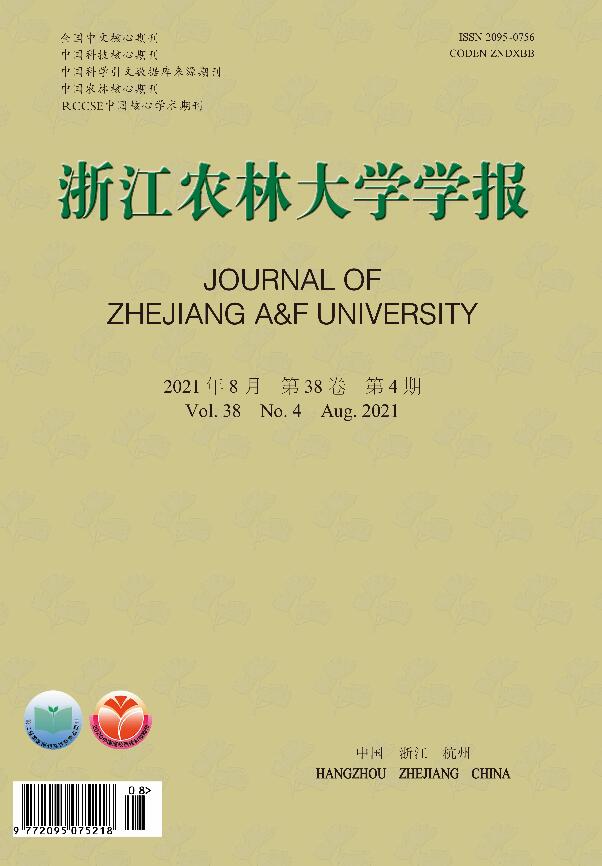





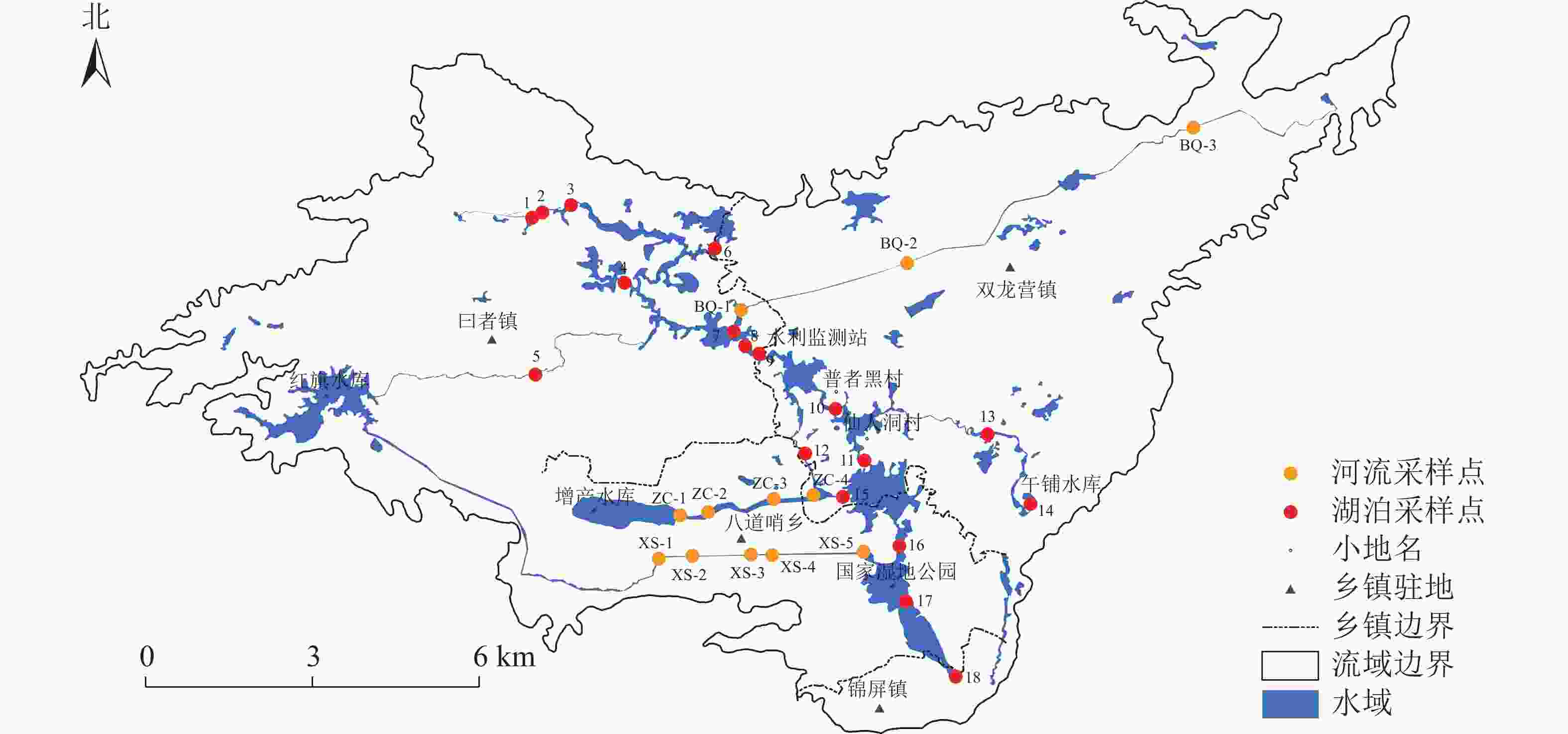





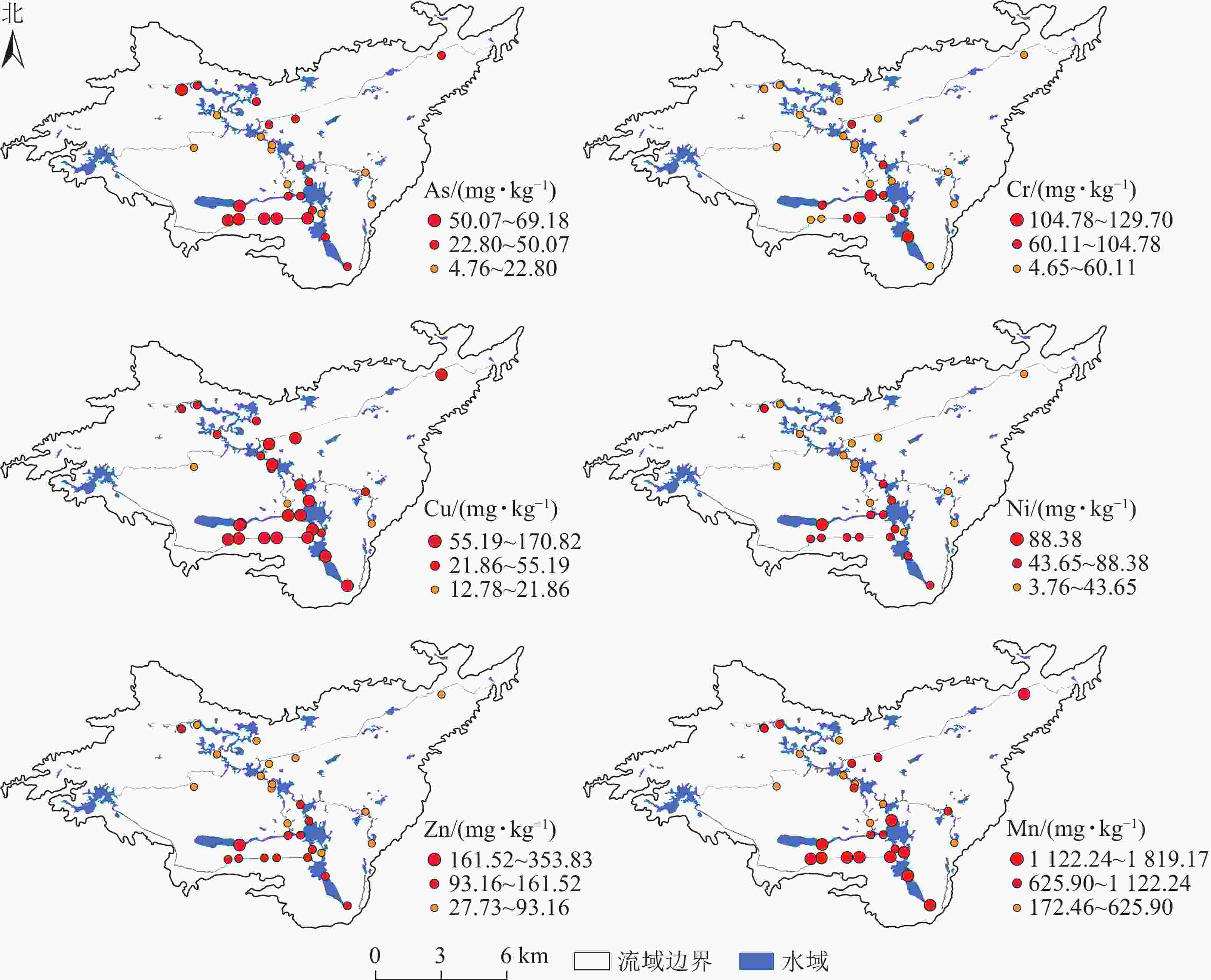
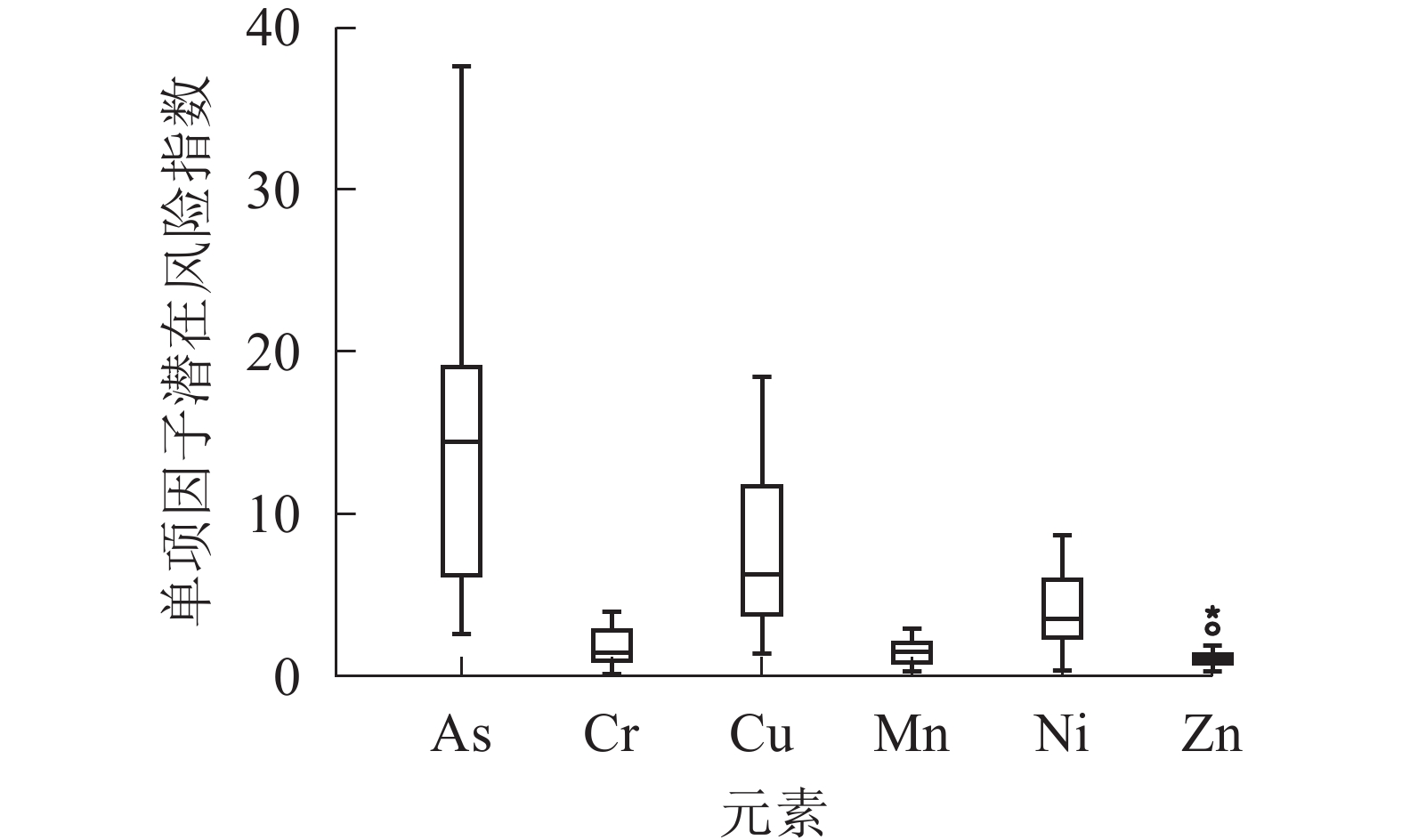

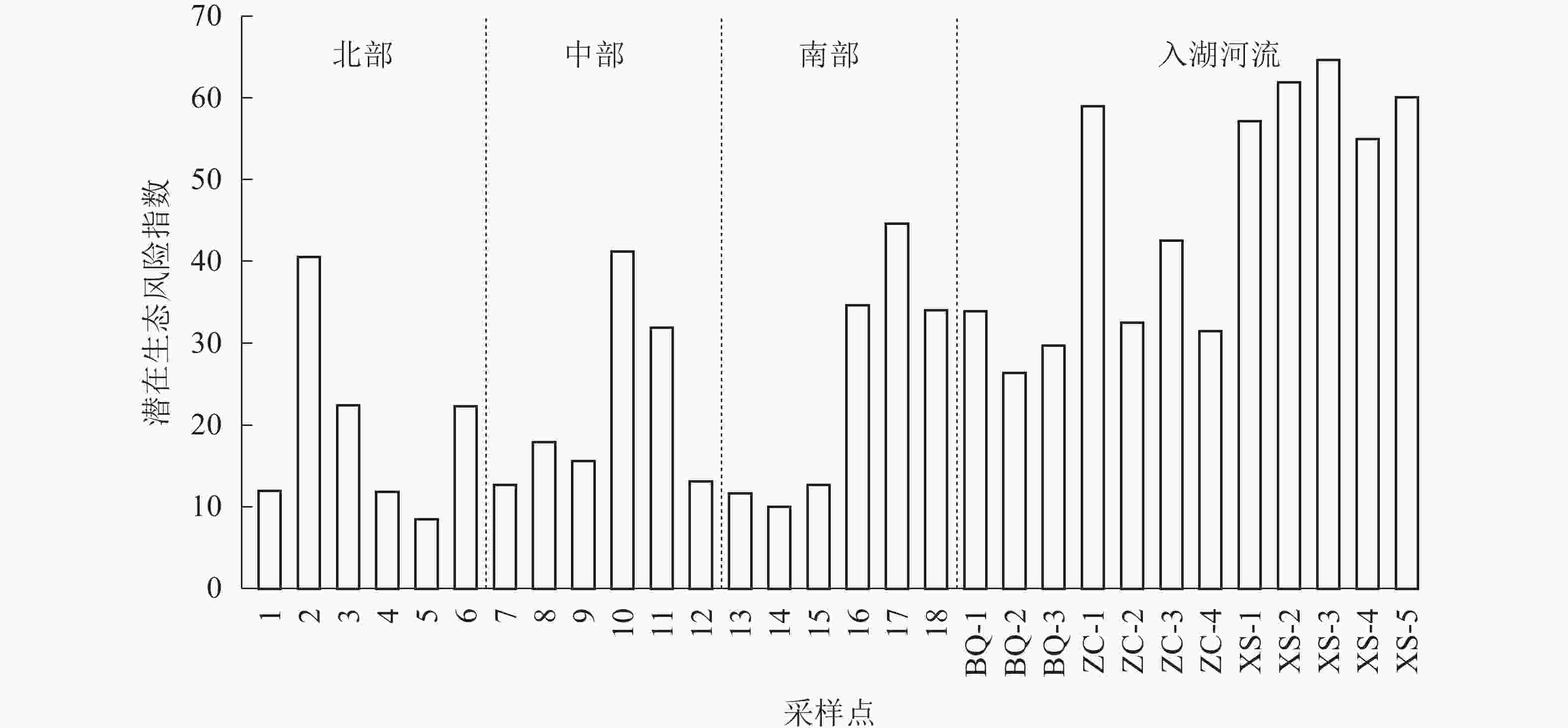

 DownLoad:
DownLoad:
